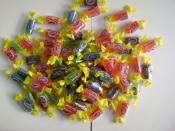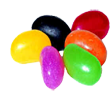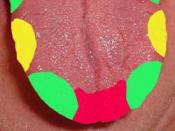1. Does the sense of smell affect our sense of taste? Through the Jellybean Experiment, we were able to examine, test, and conclude an answer to this question. The procedure of a subject tasting jellybeans with both the nose closed and open allowed us to investigate whether our two senses of smell and taste are indeed related.
2. In the Jellybean Experiment, we collected information about the subjects smoking history. In doing this, we were trying to answer the question of whether smoking affects your sense of taste.
3. In the summary table, X and Y represent the total number of correct answers when smokers results were added to the non-smokers results. X shows the total number of answers correct when the subjects nose is closed (no smell condition). On the other hand, Y stands for the total number of answers correct when the subjects nose is opened (smell condition).
The total for X is 50 and the total for Y is 111. Y is a little more than two times greater than X which makes it easy to conclude that when the nose was opened, subjects were able to answer the flavor of the jellybean more accurately. This also shows that there is a correlation between the sense of smell and the sense of taste, indicating that our smell does in fact affect our taste.
4. In the summary table, A and B represent the total number of correct answers when the no smell and smell condition were added together. A shows the total number of answers correct for smoking subjects, while B represents the total number of answers correct for nonsmoking subjects. The total for A is 50% and the total for B is 59%. Nonsmokers were able to answer the flavor correctly only 9% more than smokers. I don't believe that this is a big enough margin to conclude that smoking does affect our taste. However, the six smokers out of our data results had only been smoking for a short amount of time, 2-3 years. If we had been able to collect data from long time smokers the results may have differed and shown a greater amount of difference.
5. The Jellybean Experiment is just one of many experiments that are used to show that our sense of smell affects our sense of taste. Many of these experiments are similar to this one, in that, they test tasting a flavor with the nose both closed and open but differ in the item used for the tasting. I think that a factor that may have impacted our results is the relationship that the jellybeans have between their color and the flavor they are. For instance, red representing cherry and green signifying apple. The other two colors yellow and brown were more difficult to guess because they don't usually imply a particular flavor. I think that we could have better improved our experiment by using more unusual colors like the yellow and brown so that it wouldn't be as easy to guess the flavor based on our knowledge of the color. Another variable that needed to be looked at was age. We have learned in class that as we get older, our tastebuds die off decreasing our sensitivity and ability to taste foods. This should be a factor taken into consideration for the experiment to better improve our data results. Furthermore, to improve the Jellybean Experiment we could extend the testing to a larger group of people in order to get more data in which to compile results from.
6. An interesting tidbit of information, I think, was the amount of smokers in the classroom. Out of 35 students only six are smokers. In other classes that I have attended at Macomb Community College, I have found, for the most part, that half of the students in each class are smokers. I had just assumed that many of the people that attended classes at Macomb are smokers, and it struck me as very interesting information to find that smokers were of the minority in this class.
7. I think that a factor that may have impacted our results is the relationship that the jellybeans have between their color and the flavor they are. For instance, red usually represents cherry while green generally signifies apple. The other two colors yellow and brown were more difficult to guess because they don't usually imply a particular flavor. This correlation can be seen in jellybeans as well as other candy such as Starburst and Jolly Ranchers. However, the results were very similar for red/green jellybeans and yellow/brown jellybeans. It shows that in this experiment the color of the jellybean, whether it was the obvious red/green or the unusual yellow/brown, did not have the impact that I expected. The red/green results were a little higher in some areas but a little lower in others than the yellow/brown results.
8. There were only six smokers in the data collected. Their years of smoking averaged to 2.5 years with three people smoking for two years and three smoking for three years. It cannot be compared or contrasted because there wasn't a variety or distinct difference in the number of years smokers had been smoking. The percentages recorded didn't show a large difference.





